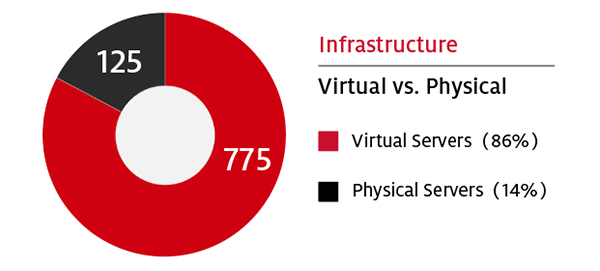Blended Data Center
OVERVIEW
Today’s blended data center is a hybrid operation that combines cloud-based and on-premises components. This approach enables the University to implement and enhance services by increasing value, service and productivity while lowering overall costs. On-premises elements provided from the University Data Center maintained by UIT include physical and virtual compute technologies integrated with large, high-speed storage arrays. The cloud-based services may range from Software as a Service (SaaS) to Platform as a Service (PaaS) to Infrastructure as a Service (IaaS), similar to the on-premises UIT virtual technologies (e.g., Microsoft Azure cloud compute and storage resources [IaaS]). Other cloud-based component examples include Microsoft OneDrive (SaaS), Microsoft Outlook/Exchange Online Email (SaaS) and Oracle Cloud Autonomous Database (PaaS).
ALIGNMENT
- With the University — Competitive Resources: Implementing carefully selected resources enables UIT to provide the most current services at optimal cost and value.
- With the UH System — Principles 1 and 9: Carefully chosen cloud services at the system level further the 1st and 9th Principles of the UH System: that the whole is greater than the sum of its parts, and that UHS maximizes opportunities for both its faculty and students to benefit from being within a system ( Appendix A ).
- With the State — Reliable & Secure Services: A blend of locally provided and cloud services gives flexibility to our strategy to assure security and continuity of operations.
- With the State — Mature IT Resource Management: This approach allows us to choose the optimal combination of service-level value and cost.

CURRENT STATE
- Higher education, like all industries, is increasingly adopting cloud technologies to replace on-premises service solutions. Many of these cloud solutions take the form of Software as a Service (SaaS) as opposed to merely lifting and shifting compute and storage workloads to hosted data centers.
- UIT has implemented Microsoft 365 SaaS including Exchange Online (email services), OneDrive (user cloud storage), SharePoint (collaborative cloud storage), and Teams
(collaborative work space and interactive meeting space). - Cloud technologies are proliferating, with more options and greater competition among providers.
- In many cases, traditional, on-premises application software marketed to higher education has become a cloud-only
offering or at least a cloud version option; e.g., Ad Astra classroom scheduling, Taleo Talent Acquisition and Onboarding. UH business process owners are increasingly considering these SaaS options over traditional on-premises applications. - The UH cloud in the Data Center has virtualized 83% of the on-premises server infrastructure.
PATH TO SUCCESS
- Lead and advise in the move to the cloud resources where applicable. The rapid expansion of cloud-based services makes it easier and more tempting for individual departments to negotiate directly with vendors of these technologies. UIT can play a key role in helping decision makers find the right fit regarding integrations, seamless interoperability with
existing applications and rightsizing the resource needs. - Maximize consistency and economies of scale. UIT will achieve this by proposing standard criteria and selection processes, helping create cost/value assessments and being a trusted advisor to UH departments.
FY2022 INITIATIVES
- Emphasize strategic rather than transactional vendor relationships.
- Make business process redesign an integral, preliminary step when replacing a technology solution or considering a move to the cloud.
- Promote and lead the definition of a business process redesign strategy that spans functional unit boundaries by engaging multiple units where applicable.